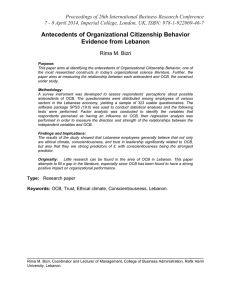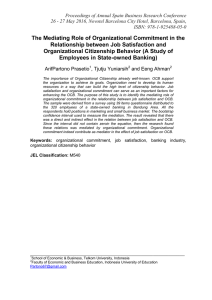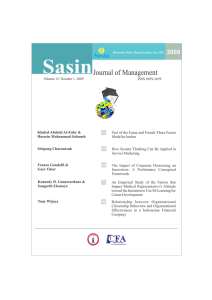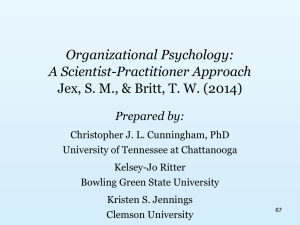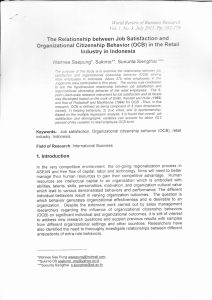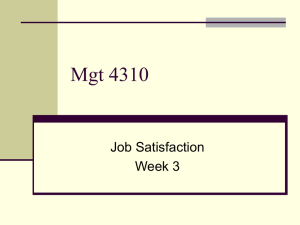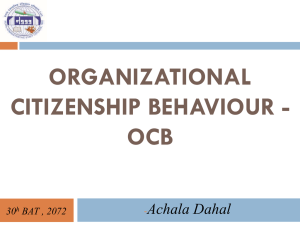Organisational Citizenship Behaviour
advertisement
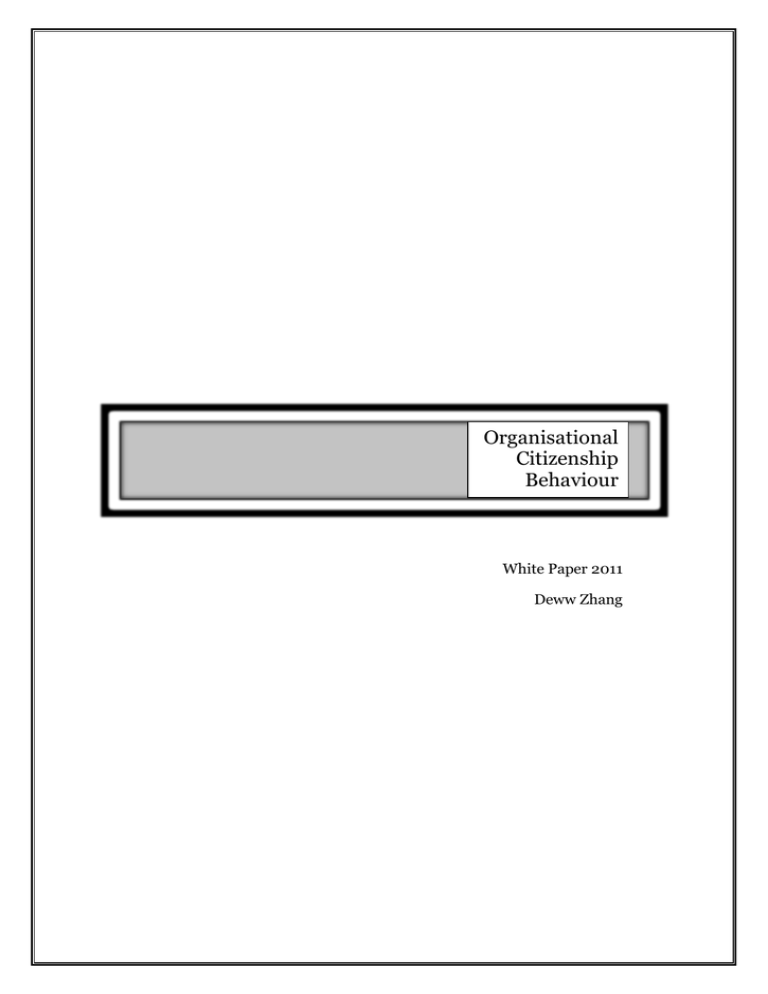
Organisational Citizenship Behaviour White Paper 2011 Deww Zhang Contents Executive Summary....………………………………………………….……………………...1 Introduction……………………………………………………………………………………2 What is OCB?.…………………………………………………………………………………3 The Benefits of OCB…………………………………………………………………………..4 Antecedents of OCB…………………………………………………………………………...6 OCB in Practice: Encouraging OCB in the workplace………………………………………...8 Conceptualising and Evaluating OCB…………………………………………………………9 OCB: A Worthy Investment………………………………………………………………….10 OCB: Potential Pitfalls………………………………………………………………………..11 Conclusion……………………………………………………………………………………12 References………………………………………………………………………….................13 PSYCH761 White Paper (OCB) Deww Zhang [4629332] Executive Summary What constitutes a good employee in the modern workplace? Are ‘good employee’ traits always quantifiable in performance appraisals, or is there something more to consider? Organisational citizenship behaviour (OCB) is a term that encompasses anything positive and constructive that employees do, of their own volition, which supports co-workers and benefits the company. Typically, employees who frequently engage in OCB may not always be the top performers (though they could be, as task performance is related to OCB), but they are the ones who are known to ‘go the extra mile’ or ‘go above and beyond’ the minimum efforts required to do a merely satisfactory job. Your organisation will benefit from encouraging employees to engage in OCB, because it has been shown to increase productivity, efficiency and customer satisfaction, and reduce costs and rates of turnover and absenteeism (Podsakoff, Whiting, Podsakoff & Blume, 2009). Though OCB is a spontaneous initiative taken by staff, you are able to promote OCB in your workplace through employee motivation, as well as giving them the opportunity to display OCB; that is, creating a workplace environment that not only allows for, but is conducive and supportive of OCB (Organ, Podsakoff & MacKenzie, 2006). Management should also be educated about OCB, and consider having OCB included in performance evaluations in order to actively encourage it among employees. Page | 1 PSYCH761 White Paper (OCB) Deww Zhang [4629332] Introduction What constitutes a good employee in a 21st century workplace? In New Zealand where organisational hierarchical structures may be flatter, or less emphasised, especially in smallor medium-sized businesses, it is important to have good relationships among co-workers. Being helpful and supportive of colleagues in a way that benefits the organisation, working towards the organisation’s goals – this is embodied in the definition of citizenship behaviour. Organisational citizenship behaviour (OCB) has garnered much academic attention since its conception. It is perceived to be something intangible; OCB is not always formally recognised or rewarded, and concepts like ‘helpfulness’ or ‘friendliness’ are also difficult to quantify. Yet OCB has been shown to have a considerable positive impact at the organisational level, enhancing organisational effectiveness from 18 to 38% across different dimensions of measurement (Podsakoff, MacKenzie, Paine & Bachrach, 2000; Ehrhart, 2004). This paper provides a definition of OCB; highlights some of the ways in which OCB enhances employee performance and wellbeing; outlines how OCB will benefit the company overall; explores ways of encouraging OCB in the workplace; introduces dimensions which could be used to measure OCB; and considers the costs involved and possible downsides in encouraging OCB in the workplace. Page | 2 PSYCH761 White Paper (OCB) Deww Zhang [4629332] What is OCB? Organisational citizenship behaviour (OCB) has undergone subtle definitional revisions since the term was coined in the late 1980s, but the construct remains the same at its core. OCB refers to anything that employees choose to do, spontaneously and of their own accord, which often lies outside of their specified contractual obligations. In other words, it is discretionary. OCB may not always be directly and formally recognised or rewarded by the company, through salary increments or promotions for example, though of course OCB may be reflected in favourable supervisor and co-worker ratings, or better performance appraisals. In this way it can facilitate future reward gain indirectly. Finally, and critically, OCB must ‘promote the effective functioning of the organisation’ (Organ, 1988, p. 4). Currently, OCB is conceptualised as synonymous with the concept of contextual performance, defined as ‘performance that supports the social and psychological environment in which task performance takes place’ (Organ, 1997, p. 95). While this reflects the flexible nature of workers’ roles in the modern workplace, and acknowledges the fact that employees do get recognised and rewarded for engaging in OCB (Van Scotter, Motowidlo & Cross, 2000; Werner, 1994), the colloquial understanding of OCB as going ‘the extra mile’ or ‘above and beyond’ to help others at work is an idea that many are familiar with, and these ideas continue to be a popular way of conceptualising OCB. Typical examples of OCB include offering to help a newcomer become familiar with his/her role and the office, a colleague who may be struggling with deadlines, or volunteering to change shifts. Importantly, OCB also encompasses organisational-related acts such as working overtime without (expectation of) remuneration, or volunteering to organise office-wide functions. Page | 3 PSYCH761 White Paper (OCB) Deww Zhang [4629332] The Benefits of OCB OCB has been shown to have a positive impact on employee performance and wellbeing, and this in turn has noticeable flow-on effects on the organisation. The correlations between OCB and job satisfaction is approximately 0.4 (Organ, 1988). There is empirical evidence for the widely-held belief that satisfied workers perform better, but this is correlational, not causal. However, certain types of performance – primarily those related to citizenship behaviour – will be affected by job satisfaction. Think of workers who are cooperative with their superiors and colleagues, willing to make compromises and sacrifices and are ‘easier to work with’, workers who ‘help out with the extra little things’ without complaining (or even offering to do so without being asked) – these behaviours are all encompassed within OCB. The effects on employee performance are threefold. Firstly, workers who engage in OCB tend to receive better performance ratings by their managers (Podsakoff et al., 2009). This could be because employees who engage in OCB are simply liked more and perceived more favourably (this has become known as the ‘halo effect’), or it may be due to more work-related reasons such as the manager’s belief that OCB plays a significant role in the organisation’s overall success, or perception of OCB as a form of employee commitment due to its voluntary nature (Organ et al., 2006). Regardless of the reason, the second effect is that a better performance rating is linked to gaining rewards (Podsakoff et al., 2009) – such as pay increments, bonuses, promotions or work-related benefits. Thirdly, because these employees have better Page | 4 PSYCH761 White Paper (OCB) Deww Zhang [4629332] performance ratings and receive greater rewards, when the company is downsizing e.g. during an economic recession, these employees will have a lower chance of being made redundant (Organ et al, 2006). How do these effects translate to organisational- Percentage of the variance which OCB accounts for in enhancing organisational effectiveness (Podsakoff et al., 2000): level outcomes? OCB is linked to lower rates of • • employee turnover and absenteeism, but on the • • organisational level increased productivity, Performance Quality: 18% Performance Quantity: 19% Financial efficiency indicators: 25% Customer service indicators: 38% efficiency and customer satisfaction, as well as reduced costs, have also been observed (Podsakoff et al, 2009). One study on OCB in grocery stores/supermarkets reports that “OCB explained approximately 20% of the variance in store profitability” (Ehrhart, 2004, p. 64). Why does OCB seem to have such compelling effects on the individual and the success of an organisation? Organ et al. (2006) has offered the following suggestions. OCB can: • enhance productivity (helping new co-workers; helping colleagues meet deadlines) • free up resources (autonomous, cooperative employees give managers more time to clear their work; helpful behaviour facilitates cohesiveness (as part of group maintenance behaviour).) • attract and retain good employees (through creating and maintaining a friendly, supportive working environment and a sense of belonging) • create social capital (better communication and stronger networks facilitate accurate information transfer and improve efficiency) Page | 5 PSYCH761 White Paper (OCB) Deww Zhang [4629332] Antecedents of OCB Since OCB is beneficial in every organisation, it is important to consider the factors which affect engagement in OCB in the workplace. The antecedents of OCB have been broadly categorised into three areas: personality/trait, attitudinal, and leadership/group factors. The influence of personality on tendency to exhibit OCB is minimal; however it does mean that some staff will be more naturally inclined towards engaging in OCB than others. The other two categories are more promising, in that attitudes can be cultivated and leadership and group characteristics can be altered to facilitate staff engagement in OCB. Personality Four of the ‘big five’ personality traits – conscientiousness, agreeableness, neuroticism and extraversion – are correlated with OCB. However, the correlations are weak, shown to be between 0.15 and 0.22 in one study (Organ & Ryan, 1995). A different study yielded a 0.24 correlation for conscientiousness (Borman, Penner, Allen & Motowidlo, 2001). The correlations between OCB and work-related attitudes, listed below, are much higher and will serve as better indicators of OCB. Attitudes The traditional measures used as valid predictors of OCB include; job satisfaction, employee engagement, organisational commitment, motivation and the level of trust between an employee and his/her co-workers and supervisors. An umbrella term ‘morale’ has been coined to cover job satisfaction, perceived fairness, affective commitment and leader consideration (Organ et al., 2006), and morale correlates with OCB at 0.69. Job satisfaction has been shown to have the strongest correlation at 0.9 (the other three factors range between 0.72 and 0.76). Page | 6 PSYCH761 White Paper (OCB) Deww Zhang [4629332] These are the job-related constructs which will affect OCB according to Chahal and Mehta (2010): • individual disposition (i.e. personality) • fairness perception (i.e. procedural and distributive justice) • motivational factors • role perception (i.e. is one’s job clearly defined or ambiguous? Does it overlap with another co-worker’s?) Leadership Characteristics The following leadership styles can encourage OCB in various ways if deployed effectively (Organ et al., 2006), though the quality of leader-member exchange (LMX) is also important. Instrumental Leadership: Facilitates role clarity – supervisor should inform subordinates clearly what is expected of them. Supportive Leadership: Concern for employee wellbeing more likely to be reciprocated with altruistic behaviours. Transformational Leadership: Facilitates motivation – inspire and support employees, high (but not unreasonable) performance expectations. Good quality LMX (which is simply the exchange relationship and manner of interaction between a superior and subordinate) is characterised by mutual trust and liking, and both parties feel inclined to reciprocate courteous and altruistic acts, which facilitates OCB. Group Characteristics Four factors have been identified in this area (Organ et al., 2006) – group cohesiveness (facilitates trust and satisfaction; desire to remain in group), team-member exchange (TMX) (influences motivation and group cohesiveness), group potency (generates synergy and enables cooperation) and perceived team support (concern for each other’s wellbeing). Improvements in any of these four areas will lead to an increase in (co-worker directed) OCB, especially if the organisation is group- and teamwork-oriented. Page | 7 PSYCH761 White Paper (OCB) Deww Zhang [4629332] OCB in Practice: Encouraging OCB in the workplace “The extent to which employees exhibit OCB is a function of ability, motivation and opportunity.” (Organ et al., 2006, p. 93) The antecedents mentioned in the previous section can be used as guidelines to improve the rate of OCB – through motivating employees for example, or promoting better relationships between supervisors and staff, and among staff in general. The following are some other tips to encourage OCB in your workplace. 1. Office social environment – a working environment that promotes or is conducive to employees demonstrating OCB. Certain types of group norms (e.g. everyone should only do the minimum amount of work required, everyone should mind his/her own business, no one should talk to the supervisor) can stifle worker initiative and spontaneity, and this will decrease incidents of OCB. Group norms may be difficult to break but other things can be done to make workers more social – such as encouraging staff to attend office functions or having more office functions, or office-wide birthday lunches. 2. Supervisor awareness – training or educating management about OCB will make them more aware of employee displays of OCB. They may choose to include OCB in their performance appraisals, or devise their own casual/informal reward system to encourage OCB. 3. Hiring practices – though the impact of personality on OCB is small, an outgoing, attentive, enthusiastic employee with a positive outlook and ‘can do’ attitude will be more inclined to engage in OCB. If psychometric testing is a part of your interview/hiring process, consider looking out for traits related to OCB, and have these staff motivate others to perform OCB. Page | 8 PSYCH761 White Paper (OCB) Deww Zhang [4629332] Conceptualising and Evaluating OCB Currently, the most popular dimensions used to measure OCB are found in the 5 factor model (Organ, 1988): Altruism: being helpful Courtesy: being polite and courteous; prevent conflict Conscientiousness: doing more than just the minimum; attention to detail (prevent/ minimise error) Civic Virtue: showing interest and involvement (e.g. keeping up to date) with the organisation; defend organisational policies and practices Sportsmanship: tolerating less-than-ideal conditions; accepting of changes and performs requests without complaints Altruism and courtesy have been grouped into individual-directed behaviour (OCB-I), while the last three are organisation-directed behaviour (OCB-O) (Williams & Anderson, 1991). There are questionnaires designed targeting each of these constructs – items such as ‘I help my colleagues out wherever possible’ would be OCB-I (altruism) while ‘I don’t mind staying back late to finish up my work even if I’m not paid’ would be an example of OCB-O (sportsmanship). These surveys can be administered across time to monitor OCB in the workplace, or to assess the effectiveness of interventions. These constructs are also useful in terms of looking at OCB as having separate facets. You may find that your office is, for example lacking more in OCB-O than OCB-I, and choose to specifically target and promote OCB-O factors, such as improving civic virtue by encouraging workers to attend non-compulsory meetings. Page | 9 PSYCH761 White Paper (OCB) Deww Zhang [4629332] OCB: A Worthy Investment One of the crucial elements of OCB is the fact that although it is often recognised and rewarded by managerial staff, employees do not necessarily make the connection between performing OCB and reward gain (especially OCB-I or altruism and courtesy-related behaviours), and do not expect rewards (Organ, 1997). Given that OCB has such a significant impact on the productivity and efficiency of the organisation, and workers do not expect to be reimbursed for their efforts, OCB should be considered an efficient way of improving organisational profitability and reducing costs through, for example, lowering rates of absenteeism and turnover. At the same time it increases employee performance and wellbeing, as cooperative workers are more productive, and OCB enhances the social environment in the workplace. Costs will be involved if managers actively seek out and reward workers for engaging in OCB, but these will have long-term benefits for the organisation (consult pages 4-5 for a detailed list of these benefits). There may also be potential costs if supervisors require training, or a meeting that takes a few hours out of their schedule, to enhance their awareness of OCB. Evaluating OCB also involves costs in administering and analysing the results of an office- or department-wide survey. The evaluation component is critical if interventions are being implemented, especially if these interventions themselves involve costs (e.g. posters, office functions). Evaluations should take place before and after interventions have been introduced, to assess whether there has been a positive impact on the levels of OCB in the workplace. Page | 10 PSYCH761 White Paper (OCB) Deww Zhang [4629332] OCB: Potential Pitfalls There are three main issues to be cautious of when promoting OCB in your workplace. 1. Discrimination Be especially wary of implicit gendered expectations – research has shown that men are rewarded for OCB more than women (Heilman & Chen, 2005), as women are expected to engage in certain types of citizenship behaviours (such as being altruistic and courteous) more than men. 2. Organisational justice In addition to the gender bias, if some supervisors reward OCB more than others, perceived unfairness may increase among certain clusters of employees. This will not only lead to a decrease in OCB among those not rewarded for it but may have other side effects related to perceived injustice, such as an increase in counterproductive behaviour (e.g. theft, absenteeism) (Marcus & Schuler, 2004). 3. Habituation If OCB is rewarded regularly, you may find that OCB levels will rise across the organisation over time. What was once considered OCB (e.g. working overtime) may become an internalised organisational norm, and is no longer spontaneous and voluntary but expected of workers. Research into this phenomenon, termed citizenship pressure, is relatively recent, and though contested, it may impact negatively on employee stress levels (Bolino, Turnley, Gilstrap & Suazo, 2010). Page | 11 PSYCH761 White Paper (OCB) Deww Zhang [4629332] Conclusion Citizenship behaviours come in many distinct shapes and forms. Traditionally thought of as the worker who ‘goes above and beyond’ the minimum requirements, it can also be the employee who takes the initiative and always offers to lend a hand; the knowledgeable, helpful and cooperative colleague; the senior staff member who is able to roll with the punches; or the friendly, approachable manager who shows the new employees around the office and introduces them to other staff. All of these types of OCB should be actively encouraged – employees support the organisation through enhancing each other’s performance and wellbeing, and this is reflected in reduced costs and increased profitability at the organisational level. Page | 12 PSYCH761 White Paper (OCB) Deww Zhang [4629332] References Bolino, M. C., Turnley, W. H., Gilstrap, J. B., & Suazo, M. M. (2010). Citizenship under pressure: What’s a ‘‘good soldier’’ to do? Journal of Organisational Behaviour, 31, 835-855. doi: 10.1002/job.635 Borman, W. C., Penner, L. A., Allen, T. D., & Motowidlo, S. J. (2001). Personality predictors of citizenship performance. International Journal of Selection and Assessment, 9(1/2), 52-69. Chahal, H. & Mehta, C. (2010). Antecedents and consequences of organizational citizenship behavior (OCB): A conceptual framework in reference to heath care sector. Journal of Services Research. Retrieved from http://findarticles.com/p/articles/mi_7629/is_201010/ai_n56229563/ Ehrhart, M. G. (2004). Leadership and procedural justice climate as antecedents of unit level organizational citizenship behavior. Personnel Psychology, 57, 61-94. Heilman, M. E., & Chen, J. J. (2005). Same behaviour, different consequences: Reactions to men’s and women’s altruistic citizenship behavior. Journal of Applied Psychology, 90(3), 431-441. doi: 10.1037/0021-9010.90.3.431 Marcus, B. & Schuler, H. (2004). Antecedents of counterproductive behavior at work:A general perspective. Journal of Applied Psychology, 89(4), 647-660. doi: 10.1037/0021-9010.89.4.647 Organ, D. W. (1988). Organizational citizenship behavior: The good soldier syndrome. USA: D.C. Heath and Company. Organ, D. W. (1997). Organizational citizenship behavior: It's construct clean-up time. Human Performance, 10(2), 85-97. doi: 10.1207/s15327043hup1002_2 Organ, D. W., Podsakoff, P. M., & MacKenzie, S. B. (2006). Organizational citizenship behavior: Its nature, antecedents, and consequences. USA: Sage Publications, Inc. Page | 13 PSYCH761 White Paper (OCB) Deww Zhang [4629332] Organ, D. W., & Ryan, K. (1995). A meta-analytic review of attitudinal and dispositional predictors of organizational citizenship behavior. Personnel Psychology, 48, 775-802. Podsakoff, N. P., Whiting, S. W., Podsakoff, P. M., & Blume, B. D. (2009). Individual- and organizational-level consequences of organizational citizenship behaviors: A metaanalysis. Journal of Applied Psychology, 94(1), 122-141. doi: 10.1037/a0013079 Podsakoff, P. M., MacKenzie, S. B., Paine, J. B., & Bachrach, D. G. (2000). Organizational citizenship behaviors: A critical review of the theoretical and empirical literature and suggestions for future research. Journal of Management, 26(3), 513-563. doi: 10.1177/014920630002600307 Van Scotter, J. R., Motowidlo, S. J., & Cross, T. C. (2000). Effects of task performance and contextual performance on systemic rewards. Journal of Applied Psychology, 85(4), 526-535. doi: 10.1037//0021-9010.85 Williams, L. J., & Anderson, S. E. (1991). Job satisfaction and organisational commitment as predictors of organizational citizenship and in-role behaviors. Journal of Management, 17, 601-617. Werner, J. M. (1994). Dimensions that make a difference: Examining the impact of in-role and extrarole behaviors on supervisory ratings. Journal of Applied Psychology, 79(1), 98-107. Page | 14

